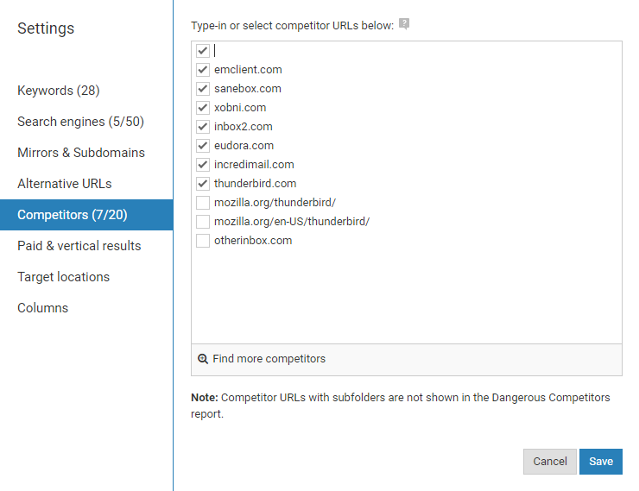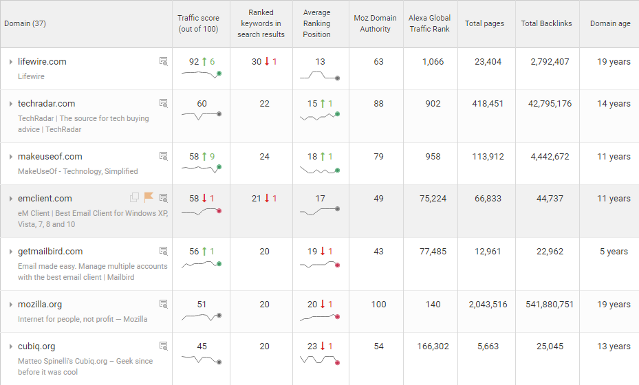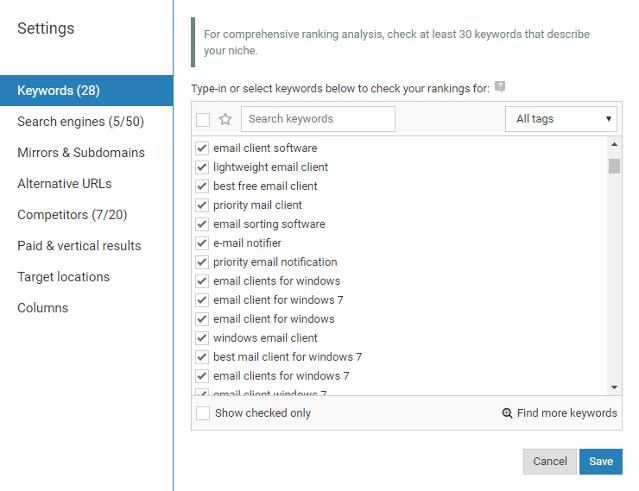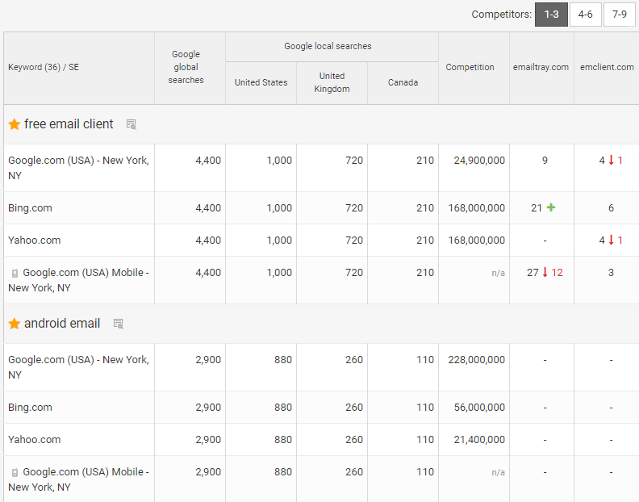
How can you beat your competitors in business? The curse of always having someone better than you plagues all but the best businessmen. And even those can’t afford to let their guard down, because as soon as they do, someone will overtake them at that instant. When every business has a site (if yours doesn’t – go make one, pronto!) and actively uses it to make money, you can often tell how well they are doing just at a glance.
Certain SEO tools can give you a lot more than just a glance. With them, you can look past the various facades and monitor competing websites in greater detail. Then you can draw conclusions about your opponents’ marketing strategies and compare them with your own.
How does conducting a competitive analysis help you? Your competitors are there so you can:
- Learn from them. They’ve got to be doing something right if they are more successful than you. The opposite is also true: by looking at companies that are less successful, you might spot their mistakes and teach yourself not to repeat them.
- Do better than they do. That’s your ultimate goal: to grow bigger, to drive in more traffic, to attract a larger clientele and to become richer than your rivals. All that is virtually impossible without analyzing your opponent… unless you are a one-of-a-kind marketing genius.
Let’s take a clever competitor analysis strategy and break it down into simple steps.
1. Revise Your Current Strategy
Before you begin analyzing your competitors’ marketing strategies, it’s a good idea to assess what you have first. When your own strengths and weaknesses are unknown, how are you going to make accurate comparisons to your competitors later? When you aren’t aware of the opportunities you have, how will you grow in the right direction? You can’t build a strategy without a basis for your future judgments.
To start, answer the following questions:
- Backlinks: how many do you have right now? Are they all beneficial to your site, or maybe there are a few bad apples among them? If you have doubts, be sure to scan your site for toxic backlinks with WebCEO.
- Keywords: are they niche, long-tail keywords, or are they too general and competitive for your site to take the lead anytime soon (if ever)? Check them with WebCEO’s Get Suggestions tool just to be safe.
- Social media activity: have you created a page for your site on each prominent social network (e.g. Facebook, Google+, LinkedIn)? Do you post there regularly? Is the content on those pages diverse? Refer to WebCEO’s Social Engagement tool for a quick rundown on your social activity.
While you’re at it, you may also want to check your site for any technical issues with WebCEO’s Technical Audit tool, just to avoid any sudden unpleasant surprises. Act of your own accord here.
2. Choose Your Competitors Carefully
A competitor is someone who targets the same audience and pursues the same business objectives as you. Be careful not to pick a fight with a company that isn’t even trying to steal your slice of pie; that would be a waste of your time and effort.
The easiest way to choose your rivals is to punch a keyword in Google’s search bar and choose whoever appears on the first page. It’s also the least optimal way. A page with nothing but links to a bunch of sites (sometimes pages of the same site) is a rather scant source of information. Instead, you could use WebCEO’s Dangerous Competitors tool. It asks for more information than just a single keyword, but the results it returns are appropriately more generous.
Enter your keywords plus the search engines you want to check for and you will get a long list full of relevant and helpful information about the best websites competing for your set of keywords. Optionally, you can also punch in a few competitor URLs that you are sure about. It will save you a little time.
But you shouldn’t stop there. Be thorough and talk to your prospective customers next. Ultimately, it’s the customers who decide whose business is the best and most-deserving of their patronage. They can be a goldmine of useful information if you ask them to answer a few questions… for example, in a survey.
Let your imagination go wild with the questions. Some of them may include:
- What kind of keywords do you use in your online research?
- What companies’ services in this niche do you use? What are their websites?
- What do you like about the service they provide online?
- What do you like about their websites?
The voice of the people can speak with more conviction than a silent SERP and is more trustworthy.
3. Visually Analyze Their Sites
Now that your list of competitors is ready, it’s finally time to dissect them. I mean their sites. Start with a visual analysis and look for the speck in their eye, just like you tried to find the beam in your own eye before. Try not to lose your spirits when your competitors prove to have much better designed websites than yours; more often than not, it’s a case of the grass being greener on the other side of the fence.
Keep your eyes peeled for things like:
- Design
- Titles
- Headers
- Content
- Calls-to-action
Think about what makes them good or bad and how you can come up with something superior in terms of user experience and engagement. Then make the necessary changes on your own site.
4. Analyze Their Ranking Keywords
There’s a good possibility your competitors are using the same keywords as you, and they are most likely outranking you, too. How do you make sure your keyword set doesn’t overlap with theirs and put you at a disadvantage?
You can spy on competitors with WebCEO’s Keyword Research tools and bring up a long list of their keywords. You aren’t going to need all of them. You just need to make sure you aren’t trying to strategically rank for the keywords that are doing much better for them than they would for you. And if you can, find in that list keywords that are relevant to your site, but aren’t placing your competitors too high in Google search results. This task, however, is better suited for a different tool: Competitor Rankings by Keyword.
5. Monitor the Competitors’ Backlinks
Backlinks are one of the most significant factors that decide how a website ranks in search engines. Monitoring your competitors’ backlink profiles in addition to your own is a good way to monitor your progress. See everyone who links to you and your competitors in a single table with WebCEO’s Competitor Backlink Spy.
You want to track the domains linking to your competitors because some of them could be persuaded to link to you, too. Additionally, it’s worth checking if there are domains that could be giving your competitors backlinks, but aren’t. Act fast and be the first to secure a backlink from them!
6. Evaluate Their Activity on Social Media Platforms
People of the 21st century like spending their time on Facebook, Twitter and such. That’s why dedicated pages with engaging, diverse, linkable content make for a good source of extra traffic. And while you can’t always predict how engaging your content will be, keeping an eye on your competitors’ pages in social media may give you a hint. Visit their pages and see for yourself: which type of content attracts more likes, shares and comments? Regular text posts? Images? Polls? Links to their blog posts? Other downloadable materials?
Get to know your target audience better, and they might just shower you with affection. Also, social media signals get picked up by search engines and provide a slight ranking boost to your site.
7. Assess Their Social Reputation and Build Your Own
The road to success is a bumpy one; you’ll most definitely receive some negative feedback on your way. I bet your rivals already have. If they have a page for user feedback and reviews on their site or on social media, it’s a good idea to read it carefully and see how they respond to criticism. A stain on your online reputation could delay your campaign’s progress, if not set it back, by months or maybe even years (depending on how badly you mess up). It’s best to know how to avoid sticky situations before you are forced to learn how to get out of them.
And it’s just as important to learn the proper ways to respond to niceties from your customers.
And remember: it’s one thing to pinpoint the strengths and weaknesses of your rivals, but your competitive strategy will succeed only if you can consistently come up with ways to outperform them. Grow big, so one day your competitors will try to use the same tricks against you!






